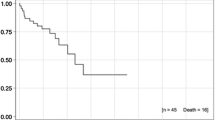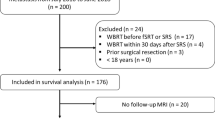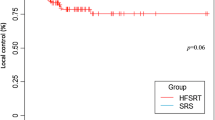Abstract
Aim
The aim of this study was to analyze the feasibility and clinical results of linear accelerator (linac-)based stereotactic radiosurgery (SRS) or fractionated stereotactic radiotherapy (SFRT) with flattening filter-free (FFF) volumetric modulated arc therapy (VMAT) in elderly patients affected by brain metastases (BMs).
Patients and methods
Patients selected for the present analysis were ≥65 years old with a life expectancy of >3 months, a controlled or synchronous primary tumor, and <10 BMs with a diameter <3 cm. All patients were treated with FFF linac-based SRS/SFRT. The prescribed total dose (15–30 Gy/1–5 fractions) was based on BM size and proximity to organs at risk (OAR). Toxicity was assessed according to the Common Terminology Criteria for Adverse Events (CTCAE) v4.0. MedCalc v18.2 (MedCalc Software, Ostend, Belgium) was used for statistical analysis.
Results
From April 2014 to December 2017, 40 elderly patients with 110 BMs were treated by FFF linac-based SRS/SFRT. With a median follow-up of 28 months (range 6–50 months), median and 1‑year overall survival were 9 months and 39%, respectively; median intracranial progression-free survival was 6 months. At the time of the analysis, local control was reported in 109/110 BMs (99.1%): 12 BMs had a complete response; 51 a partial response; 46 showed stable disease. One BM (0.9%) progressed after 2 months. BM volume (<1 cc) and higher SRS/SFRT dose correlated to treatment response (p = 0.01 and p = 0.0017, respectively). No adverse events higher than grade 2 were observed.
Conclusion
The present findings highlight the feasibility, safety, and effectiveness of FFF linac-based SRS/SFRT in elderly patients with BMs.
Zusammenfassung
Hintergrund
Ziel der Studie ist es, die Machbarkeit und erste klinische Ergebnisse einer linearbeschleuniger-(linac-)basierten stereotaktischen Radiochirurgie (SRS) oder fraktionierten stereotaktischen Strahlentherapie (SFRT) mit flattening-filter-freier (FFF) volumenmodulierter Rotationsbestrahlung (VMAT) für ältere Patienten mit Hirnmetastasen (HM) zu analysieren.
Materialien und Methoden
Für die vorliegende Analyse wurden Patienten mit einem Alter >65 Jahren und einer Lebenserwartung von >3 Monaten bei kontrolliertem oder synchronem Primärtumor ausgewählt, die bei <10 HM mit einem Durchmesser <3 cm mit FFF linac-basierter SRS/SFRT behandelt wurden. Die applizierte Gesamtdosis (15–30 Gy/1–5 Fraktionen) war von der Größe der HM sowie deren Lage zu Risikoorganen abhängig. Für jeden Patienten wurde ein FFF-VMAT-Plan erstellt. Die Toxizität wurde nach den Common Terminology Criteria for Adverse Events (CTCAE) v4.0 bewertet. MedCalc v18.2 (MedCalc Software, Ostend, Belgien) wurde für die statistische Analyse verwendet.
Ergebnisse
Von April 2014 bis Dezember 2017 wurden 40 ältere Patienten mit 110 HM mit FFF linac-basierter SRS/SFRT behandelt. Bei einer medianen Nachbeobachtungszeit von 28 Monaten (Spanne 6–50 Monate) betrug das mediane und 1‑Jahres-Gesamtüberleben 9 Monate bzw. 39 % und das mediane intrakranielle progressionsfreie Überleben 6 Monate. Zum Zeitpunkt der Analyse waren 109/110 HM (99,1 %) lokal kontrolliert: 12 HM hatten eine vollständige Remission, 51 eine partielle Remission und 46 eine stabile Erkrankung. Eine HM (0,9 %) hatte nach 2 Monaten einen lokalen Progress. Das Volumen der HM (<1 cm3) und eine höhere SRS/SFRT-Dosis korrelierten mit dem Therapieansprechen (jeweils p = 0,01 und p = 0,0017). Es wurden keine Nebenwirkungen >Grad 2 beobachtet.
Schlussfolgerung
Die Ergebnisse der Studie bestätigen die Machbarkeit, Sicherheit und Wirksamkeit von FFF linac-basierter SRS/SFRT bei älteren Patienten mit HM.



Similar content being viewed by others
References
Mehta MP, Tsao MN, Whelan TJ et al (2005) The American society for therapeutic radiology and oncology (ASTRO) evidence-based review of the role of radiosurgery for brain metastasis. Int J Radiat Oncol Biol Phys 63:37–46
Patchell RA (2003) The management of brain metastases. Cancer Treat Rev 29:533–540
Lin X, DeAngelis LM (2015) Treatment of brain metastases. J Clin Oncol 33:3475–3484
Yancik R, Ries LA (2004) Cancer in older persons: an international issue in an aging world. Semin Oncol 31:128–136
Rowland JH, Yancik R (2006) Cancer survivorship: The interface of aging, comorbidity, and quality care. J Natl Cancer Inst 98:504–505
Gaspar L, Scott C, Rotman M et al (1997) Recursive partitioning analysis (RPA) of prognostic factors in three Radiation Therapy Oncology Group (RTOG) brain metastases trials. Int J Radiat Oncol Biol Phys 37:745–751
Lutterbach J, Bartelt S, Stancu E et al (2002) Patients with brain metastases: hope for recursive partitioning analysis (RPA) class 3. Radiother Oncol 63:339–345
Rades D, Evers JN, Veninga T et al (2011) Shorter-course whole-brain radiotherapy for brain metastases in elderly patients. Int J Radiat Oncol Biol Phys 81:e469–e473
Sperduto PW, Kased N, Roberge D et al (2012) Summary report on the graded prognostic assessment: an accurate and facile diagnosis-specific tool to estimate survival for patients with brain metastases. J Clin Oncol 30(4):419–425
NCCN (2018) NCCN guidelines. https://www.nccn.org/professionals/physician_gls/f_guidelines.asp
Kocher M, Wittig A, Piroth MD et al (2014) Stereotactic radio-surgery for treatment of brain metastases. A report of the DEGRO Working Group on Stereotactic Radiotherapy. Strahlenther Onkol 190(6):521–532
Scoccianti S, Ricardi U (2012) Treatment of brain metastases: review of phase III randomized controlled trials. Radiother Oncol 102:168–179
Andrews DW, Scott CB, Sperduto PW et al (2004) Whole brain radiation therapy with or without stereotactic radiosurgery boost for patients with one to three brain metastases: phase III results of the RTOG 9508 randomised trial. Lancet 363:1665–1672
Aoyama H, Shirato H, Tago M et al (2006) Stereotactic radiosurgery plus whole-brain radiation therapy vs stereotactic radiosurgery alone for treatment of brain metastases: a randomized controlled trial. JAMA 295:2483–2491
Yamamoto M, Serizawa T, Shuto T et al (2014) Results of stereotactic radiosurgery for patients with multiple brain metastases (JLGK0901): a multi-institutional prospective study. Lancet Oncol 15:387–395
DeAngelis LM, Delattre JY, Posner JB (1989) Radiation-induced dementia in patients cured of brain metastases. Baillieres Clin Neurol 39:789–796
Crossen JR, Garwood D, Glatstein E et al (1994) Neurobehavioral sequelae of cranial irradiation in adults: a review of radiation-induced encephalopathy. J Clin Oncol 12:627–642
Fiorentino A, Tebano U et al (2017) Stereotactic ablative radiation therapy for brain metastases with volumetric modulated arc therapy and flattening filter free delivery: feasibility and early clinical results. Radiol Med 122(9):676–682
Ruggieri R, Naccarato S, Mazzola R et al (2018) Linac-based VMAT radiosurgery for multiple brain lesions: comparison between a conventional multi-isocenter approach and a new dedicated mono-isocenter technique. Radiat Oncol 13(1):38
Noel G, Bollet MA, Noel S et al (2005) Linac stereotactic radiosurgery: an effective and safe treatment for elderly patients with brain metastases. Int J Radiat Oncol Biol Phys 63(5):1555–1561
Kim SH, Weil RJ, Chao ST et al (2008) Stereotactic radiosurgical treatment of brain metastases in older patients. Cancer 113(4):834–840
Minniti G, Esposito V, Clarke E et al (2013) Stereotactic radiosurgery in elderly patients with brain metastases. J Neurooncol 111(3):319–325
Watanabe S, Yamamoto M, Sato Y et al (2014) Stereotactic radiosurgery for brain metastases: a case-matched study comparing treatment results for patients 80 years of age or older versus patients 65–79 years of age. J Neurosurg 121(5):1148–1157
Park JY, Moon KS, Lee KH et al (2015) Gamma knife radiosurgery for elderly patients with brain metastases: evaluation of scoring systems that predict survival. BMC Cancer 15:54
Yomo S, Hayashi M et al (2016) Is upfront stereotactic radiosurgery a rational treatment option for very elderly patients with brain metastases? A retrospective analysis of 106 consecutive patients age 80 years and older. BMC Cancer 16(1):948
Roh TH, Choi MS, You N et al (2018) Identifying candidates for gamma knife radiosurgery among elderly patients with brain metastases. J Neurooncol 137(3):559–565
Wiggenraad R, Verbeek-de Kanter A, Kal HB et al (2011) Dose-effect relation in stereotactic radiotherapy for brain metastases. A systematic review. Radiother Oncol 98(3):292–297
Koay E, Sulman EP (2012) Management of brain metastasis: past lessons, modern management, and future considerations. Curr Oncol Rep 14(1):70–78
Maclean J, Fersht N, Singhera M et al (2013) Multi-disciplinary management for patients with oligometastases to the brain: results of a 5 years cohort study. Radiat Oncol 8:156
D’Agostino GR, Autorino R, Pompucci A et al (2011) Whole-brain radiotherapy combined with surgery or stereotactic radiotherapy in patients with brain oligometastases: long-term analysis. Strahlenther Onkol 187(7):421–425
Balducci M, Autorino R, Chiesa S et al (2015) Radiosurgery or fractionated stereotactic radiotherapy plus whole-brain radioherapy in brain oligometastases: a long-term analysis. Anticancer Res 35(5):3055–3059
Franco P, De Bari B, Ciammella P et al (2014) The role of stereotactic ablative radiotherapy in oncological and non-oncological clinical settings: highlights from the 7th Meeting of AIRO—Young Members Working Group (AIRO Giovani). Tumori 100(6):e214–e219
Brown PD, Jaeckle K, Ballman KV et al (2016) Effect of radiosurgery alone vs radiosurgery with whole brain radiation therapy on cognitive function in patients with 1 to 3 brain metastases: a randomized clinical trial. JAMA 316(4):401–409
Sahgal A, Aoyama H, Kocher M et al (2015) Phase 3 trials of stereotactic radiosurgery with or without whole-brain radiation therapy for 1 to 4 brain metastases: individual patient data meta-analysis. Int J Radiat Oncol Biol 91(4):710–717
Robin TP, Camidge DR, Stuhr K et al (2018) Excellent outcomes with radiosurgery for multiple brain metastases in ALK and EGFR driven non-small cell lung cancer. J Thorac Oncol 13(5):715–720
Lutterbach J, Bartelt S, Momm F et al (2005) Is older age associated with a worse prognosis due to different patterns of care? A long-term study of 1346 patients with glioblastomas or brain metastases. Cancer 103(6):1234–1244
Alongi F, Fiorentino A, Gregucci F (2018) First experience and clinical results using a new non-coplanar mono-isocenter technique (HyperArc™) for Linac-based VMAT radiosurgery in brain metastases. J Cancer Res Clin Oncol. https://doi.org/10.1007/s00432-018-2781-7
Kubicek GJ, Turtz A, Xue J et al (2016) Stereotactic radiosurgery for poor performance status patients. Int J Radiat Oncol Biol Phys 95(3):956–959
Fiorentino A, Mazzola R, Giaj Levra N et al (2018) Comorbidities and intensity-modulated radiotherapy with simultaneous integrated boost in elderly breast cancer patients. Aging Clin Exp Res 30(5):533–538
Fiorentino A, Gregucci F, Mazzola R et al (2018) Intensity modulated radiotherapy and hypofractionated volumetric modulated arc therapy for elderly patients with breast cancer: comparison of acute and late toxicities. Radiol Med. In press
Fiorentino A, Balducci M, De Bonis P et al (2015) Can elderly patients with newly diagnosed glioblastoma be enrolled in radiochemotherapy trials? Am J Clin Oncol 38(1):23–27
Sneed PK, Suh JH, Goetsch SJ et al (2002) A multi-institutional review of radiosurgery alone vs. radiosurgery with whole brain radiotherapy as the initial management of brain metastases. Int J Radiat Oncol Biol Phys 53:519–526
Manon R, O’Neill A, Knisely J et al (2005) Eastern Cooperative Oncology Group. Phase II trial of radiosurgery for one to three newly diagnosed brain metastases from renal cell carcinoma, melanoma, and sarcoma: an Eastern Cooperative Oncology Group study (E 6397). J Clin Oncol 23:8870–8876
Kocher M, Soffietti R, Abacioglu U et al (2006) Adjuvant whole-brain radiotherapy versus observation after radiosurgery or surgical resection of one to three cerebral metastases: results of the EORTC 22952–26001 study. J Clin Oncol 29:134–141
Rieber J, Tonndorf-Martini E, Schramm O et al (2016) Radiosurgery with flattening-filter-free techniques in the treatment of brain metastases: plan comparison and early clinical evaluation. Strahlenther Onkol 192(11):789–796
Stieler F, Simeonova A, Lohr F (2013) Intensity modulated radiosurgery of brain metastases with flattening filter-free beams. Radiother Oncol 109(3):448–451
Navarria P, Ascolese AM, Mancosu P et al (2013) Volumetric modulated arc therapy with flattening filter free (FFF) beams for stereotactic body radiation therapy (SBRT) in patients with medically inoperable early stage non small cell lung cancer (NSCLC). Radiother Oncol 107:414–418
Reggiori G, Mancosu P, Castiglioni S et al (2012) Can volumetric modulated arc therapy with flattening filter free beams play a role in stereotactic body radiotherapy for liver lesions? A volume-based analysis. Med Phys 39:1112–1118
Scorsetti M, Alongi F, Castiglioni S et al (2011) Feasibility and early clinical assessment of flattening filter free (FFF) based stereotactic body radiotherapy (SBRT) treatments. Radiat Oncol 6:113
Alongi F, Fogliata A, Clerici E et al (2012) Volumetric modulated arc therapy with flattening filter free beams for isolated abdominal/pelvic lymph nodes: report of dosimetric and early clinical results in oligometastatic patients. Radiat Oncol 7:204
Terem I, Ni WW, Goubran M et al (2018) Revealing sub-voxel motions of brain tissue using phase-based amplified MRI (aMRI). Magn Reson Med. https://doi.org/10.1002/mrm.27236
Author information
Authors and Affiliations
Corresponding author
Ethics declarations
Conflict of interest
F. Gregucci, A. Fiorentino, S. Corradini, V. Figlia, R. Mazzola, F. Ricchetti, R. Ruggieri, and F. Alongi declare that they have no competing interests.
Ethical standards
All procedures performed in studies involving human participants were in accordance with the ethical standards of the institutional and/or national research committee and with the 1964 Helsinki declaration and its later amendments or comparable ethical standards. Informed consent was obtained from all individual participants included in the study.
Additional information
F. Gregucci and A. Fiorentino contributed equally to the manuscript.
Rights and permissions
About this article
Cite this article
Gregucci, F., Fiorentino, A., Corradini, S. et al. Linac-based radiosurgery or fractionated stereotactic radiotherapy with flattening filter-free volumetric modulated arc therapy in elderly patients. Strahlenther Onkol 195, 218–225 (2019). https://doi.org/10.1007/s00066-018-1405-0
Received:
Accepted:
Published:
Issue Date:
DOI: https://doi.org/10.1007/s00066-018-1405-0




